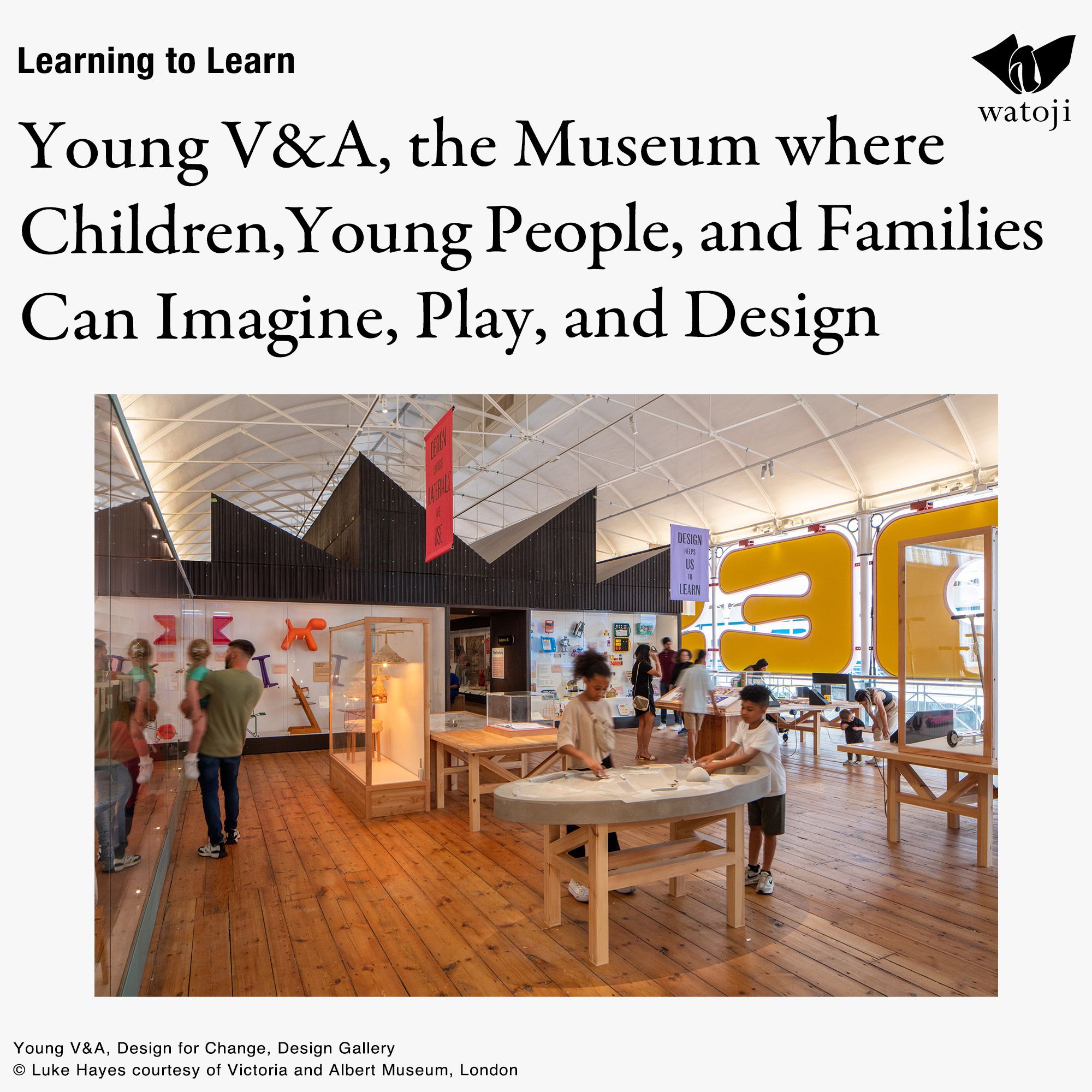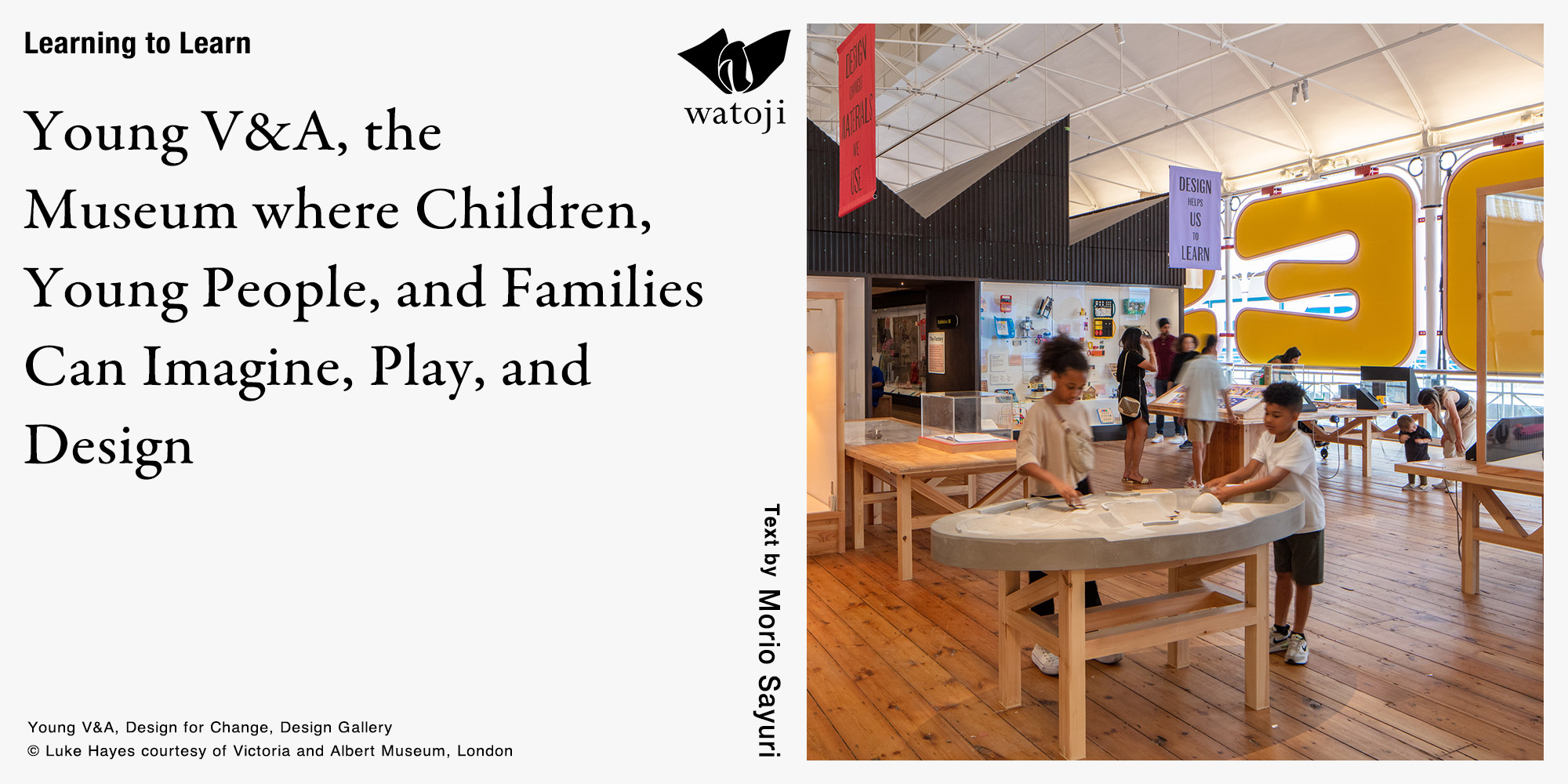In this series we introduce people who are engaged with children’s learning and learning environments, focusing on their ideas and aspirations. What should be done so that children’s learning will be lively and animated and so that they will grasp the fascination, beauty, and importance of traditional crafts? Based the issues she faces in communicating her own field, the author (a conservator) will ask her interviewees the questions she herself would like to ask about their work, and share the perspectives she gains.
Page Index

© Luke Hayes courtesy of Victoria and Albert Museum, London
The collection of the Victoria and Albert Museum (V&A) includes arts and crafts from around the world. The V&A Museum of Childhood, a V&A annex that reopened on July 1 as the Young V&A after extensive renovation, aims to be a museum where children, young people, and families can imagine, play, and design. Kirsty Sullivan worked as Senior Producer, Formal Learning, Young V&A from 2017–2023, and I asked her about important points for making learning come alive. (Sullivan assumed a new position as Head of Learning and Participation at the Quentin Blake Centre for Illustration after this interview took place.)

Learning from Each Other Workshop

© Luke Hayes courtesy of Victoria and Albert Museum, London
Seven years in the making, Young V&A reopened this summer in London’s Bethnal Green. In its previous incarnation as the V&A Museum of Childhood, the museum attracted numerous visitors, many of them repeaters. “During the three years the museum was closed, we worked hard in our local community making sure we weren’t forgotten and talking to people about what they could expect to see and do.”

© Victoria and Albert Museum
One programme was called “Design can make things last for longer.” Aimed at visitors aged 11 to 22, it was a four-day workshop which offered “tangible” (hands-on) experiences that seek to build connections with the museum’s collections. “Design can make things last for longer” is also the name of one of the Young V&A’s exhibits.
Participants from a local youth centre visited the V&A’s storerooms where curator staff explained various articles that will be going on display. Together with designers, participants made new items and learned about the materials used to make them. Their work led to discussions about sustainability and design.
The programme was an opportunity for not only participants but also for museum staff to generate new ideas, creating an interactive learning environment. This experience of interactive learning has developed into a session for schools in the new learning programme.
Respecting Everyone’s Creativity
An important concept at Young V&A is “connect,” referring to maintaining ties with the local community and listening to their expectations for the museum, and “co-design.” According to the museum, co-design encompasses designing physical objects as well as systems. The development process involves not simply taking into account users’ opinions but also actively incorporating creative concepts.
The museum’s new galleries display works co-created or co-designed by the community’s children and young people working with local makers and designers. The co-design process is clearly valued and conveys a powerful message.
According to Sullivan, “We feel it’s vital for these young people to have their creative vision and skills showcased alongside those of working designer makers, and to have their voices foregrounded. They have been so important to the development of the museum, from the new staircase co-designed with local primary schools, to the co-created quilt exploring sustainable fashion; to a set of zines made by a local secondary school. Where young people see the voices of other young people being valued, they will hopefully feel more confident about sharing their own ideas and creations.”

© Victoria and Albert Museum
“What we have found engages visitors in public spaces is opportunities for families to drop in to a safe space, build and create together—we’ve provided ideas and materials, such as the Imagination Playground and loose parts curated by artists/designers, or Emilie Queney’s Happy Squares—but we haven’t prescribed an outcome. This freedom has been really important as it transcends language or skills barriers, allowing people to engage on their own terms.”

© Luke Hayes courtesy of Victoria and Albert Museum, London
To allow everyone to participate according to their own mode of expression, there are no prescribed outcomes. Otherwise, children would be prevented from learning from their own perspectives. As Sullivan says, “Children have their own beliefs and opinions and have the capacity to self-select how they learn.
“Often these very tiny participants are non-verbal, but they are still able to communicate what they are interested in through grabbing or playing with textures and objects, manipulating them or otherwise engaging with their environment. We also work with children with special educational needs and disabilities, and many of these young people communicate their opinions in the same way.
“Three-to-five-year-olds have strong opinions on what they do or don’t like or want to do—any parent will tell you this! They tend to be involved in co-design and co-creation as family groups, rather than as individuals, but even in their school settings they direct their own learning through engaging with things they are interested in, self-selecting activities.”

Some programmes feature a tactile element to facilitate learning. In the formal learning (mainly included in school lessons) that Sullivan oversees, students are encouraged to handle objects and feel their weight, hardness, and temperature and explore their texture. They can turn them around and upside down to imagine how they work and how they appear in three dimensions.
“These new experiences connect with their past experiences, so handling materials in this way adds an extra layer of learning. Looking at things behind glass doesn’t give you any of these things and—in the case of the Design Gallery where we are mainly looking at things that were designed to be used—removes them from people’s own experience.
“Naturally, objects in the collections cannot be handled directly, so during lessons we are trying to use replicas or, when the items are industrial products, similar objects.”
Workshops Have a Positive Impact
I’m certain that many people can identify with how touching and handling hand-made objects stimulates interest and deepens learning. It’s difficult for people nowadays to see the process behind how products, whether hand-made or industrial, are created, so touching or handling things provides learning opportunities.
“We are currently putting together a series of films about making and manufacturing techniques, linking domestic and industrial. We’ll also be running demonstrations in the Design Gallery, showing people making and working, and building a materials library of things that show process rather than perfection.”
Given my personal interest in materials and processes, this materials library certainly sounds intriguing.

© Victoria and Albert Museum, London
Speaking of making, Sullivan made an interesting point in the context of fewer and fewer people taking up traditional crafts in countries around the world. “There has been an enormous surge in interest in traditional crafts in the last few years, and we’re seeing this in young people as we work with them—many are learning skills from their parents or grandparents, especially in communities from Bangladesh and the African nations. TikTok, amazingly, is also becoming a home for crafters to share skills.”
During the interview, I was struck by Sullivan’s frequent mention of words like “together” and “connecting,” in addition to sharing. To make this happen, everyone should find their own voice and expression and respect each other. It seems to me that in its workshops and programmes, Young V&A is stressing that experience should create opportunity so that everyone can exert a positive influence on their peers and on the community. I really look forward to the next time I will have a chance to visit Young V&A.
Exhibition Information from Young V&A
Japan: Myths to Manga
Japan: Myths to Manga opens at Young V&A on 14 October 2023. From sky to sea, and into the forest and city, the exhibition takes us on an exciting and atmospheric trip through Japanese history to explore how landscape and folklore have influenced popular culture and design. Alongside a series of sensory interactives and activities, the exhibition features films such as My Neighbour Totoro (1988) and Ponyo (2008) from the iconic animation studio, Studio Ghibli, a manga-inspired coat by Comme des Garçons, and dizzying heel-less shoes by Noritaka Tatehana, plus plenty of Pokémon. Also on show is Doodle Champion Island Games (2021), a role-playing browser game created by Google with Studio 4°C, epic sculptures by Keita Miyazaki and a moving installation of 1,000 cranes – a symbol of remembrance from the Hiroshima Peace Memorial Park in Japan.
Japan: Myths to Manga is supported by Toshiba, with additional support from Cockayne – Grants for the Arts, a donor advised fund of the London Community Foundation.







